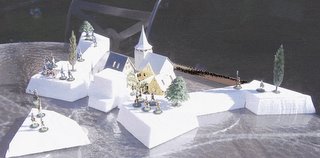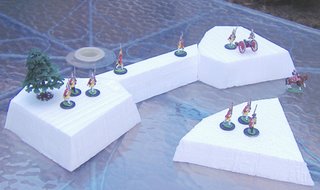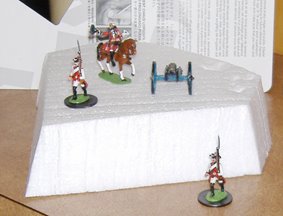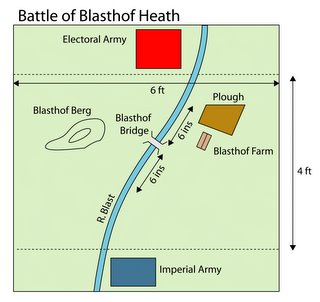A Blog dedicated to the creation of my Seven Years' War Army in miniature. Among other things!
Wednesday, March 29, 2006
A Few More Thoughts on Fortresses
Consider this: If you have two demi-bastions, a bastion and two curtain walls, you have the makings of a crown-work. Two bastions and a curtain on their own make an acceptable horn-work, as well. These structures served to enclose detached suburbs, or extend the work deep into the countryside if needed.
Another feature that catches my eye would be to build a 'cavalier' or elevated battery inside a bastion, although I think I might have to re-build my bastions on a rather roomier basis.
Dressing the Polystyrene
At the moment I'm working at the rate of getting one-and-a-bit slabs clad a day.
Pictures to follow soon.
Sunday, March 26, 2006
More Fortress than you could shake a stick at.



The basic structure is now complete but for two more ravelins.
I'm starting to think about doing a glacis. I could do it with a 15-20mm slab of polystyrene, not too wide, carved at a shallow angle. Where the pieces would meet could be done by 'eye' I think. Line the inside with bamboo skewers to make the palisade and that'd be about it.
Saturday, March 25, 2006
Fortress

This represents about two hours' work with stencils, white glue and hot wire cutter.
To round the basics out, I want to do another wall and another with a gateway. Additionally, I'll also do another two half-bastions to butt up against the table edges. Then I'll probably need two more ravelins.
For fun I'll do another wall, a ravelin and a bastion that have been breached.
Then there's the bridge I'll have to do to link one of the ravelins to the gate.
They'll all need parapets. I'll probably cut them from foam-core card as simple vertical parapets. The real things were very thick, with gun-ports cut in them, but in this scale I don't think it will matter too much. Besides, foam-core is a little too inarticulate a material to take that kind of detail, sadly.
Note the tree on one of the bastions. They used to grow them there so the roots would bind the earthern fabric of the bastion more closely together. Furthermore, the wood would furnish both fuel and the materials from which gun carriages could be manufactured.
Friday, March 24, 2006
Bastion
 I bought a hot wire cutter today and used it to trim up some of my polystyrene hills for Blasthof. It was a novel experience, and one I haven't had since primary school.
I bought a hot wire cutter today and used it to trim up some of my polystyrene hills for Blasthof. It was a novel experience, and one I haven't had since primary school.Having been pondering fortress construction for a good few years I was amazed to turn out an entire bastion in about 30 minutes with the aid of a couple of templates.
I'll do another tomorrow and a ravelin as well.
My hot wire cutter is my best new friend.
Thursday, March 23, 2006
Terrain for Blasthof
The ground and the river will be green paper and blue cellophane held down with double-sided sticky-tape.
The plough will be corrugated cardboard covered patchily with sand and PVA and painted brown.
Blasthof Farm will be a Dapol thatched cotage I own.
The Blasthof Berg will simply be two pieces of polystyrence cut with a hot wire cutter an painted the same shade of green as the paper.
The bridge will probably be foamcore and card, painted to simulate stone.
For trees I have a few Merit items. From the same purchase I also have a few fence-lengths and a couple of hedges that will mark the edges of the plough and the farm-yard.
I'll mark the fordable area of the river with brown paper to represent the muddy bank.
Wednesday, March 22, 2006
Some Organisational notes for Blasthof.
There are four eight-figure "fusilier" companies, and one eight-figure "grenadier" company. There are two ensigns and a mounted colonel.
What's the problem? I hear you cry.
Each company is either six or seven privates with either an officer/NCO or an officer/NCO and a drummer to round the company out to eight figures.
All of my grenadier companies are manned by grenadiers in their distinctive headware.
Even for the 32 figure unit, I am going to pull up short by a half-dozen figures when it comes to organising them*. Time to get painting again!
I'm sure I have some RSM 95 castings floating about somewhere.
*Fortunately they are singly-based, so re-arranging my units won't cause any major headaches.
Tuesday, March 21, 2006
CHARGE! - The Basic Rules
For those of us who may not have the book:
The Move consists of five phases:
- Movement
Normal | Hills | Woods | Marshes | Obstacles | |
Cavalry | 12 | 6 | 6 | Na | 6 |
Infantry | 6 | 3 | 3 | 3 | 3 |
Artillery | 6 | 3 | Na | Na | 3 |
- N.B. All carriages, pontoons &c move at infantry speed.
- Woods: Guns cannot pass through woods; cavalry can only move through them in single file; infantry can only move at half speed.
- Marshes: These are impassable to cavalry and guns. May be impassable to infantry or passable at half speed only.
.
- Firing
- Artillery
i. The gun must be manned by at least 4 soldiers. The target must be visible from the gun and not more than 45° left or right of the direction in which the gun is pointing. The path of the shell or round-shot must not be closer than one inch to any other troops of the same army.
ii. If these conditions are met, measure range to target, then throw dice:
Range to Target&Dice Score to Hit
3’ ****************** 6
2’6” **************** 5
2’ ****************** 4
1’6” **************** 3
1’ ****************** 2
6” ****************** Automatic Hit
iii. If the target is hit, throw dice to decide the ‘standard’ number of casualties. If the range is more than nine inches, the number on the dice is halved to give the standard number; if nine inches or less, the number on the dice is the standard number.
- Infantry fire
i. Target must be visible to firer, not more than 45° to right or left, and lines of fire must not pass closer than one inch to own side.
ii. Long range (3” to 6”) - throw one dice per 8 infantrymen capable of firing. The number on each dice is halved for the standard number of casualties.
iii. Short range (0 to 3”) - throw one dice per eight infantrymen as above, but the number on each dice is the standard number of casualties.
iv. A dice can be thrown for not less than 4 infantrymen. The number on the dice is then halved, and should be halved again if the fire is at long range.
v. Infantry receiving fire can count their casualties when returning that particular fire, casualties must then be immediately removed.
- Casualties
- A fraction of a casualty is disregarded if it is less than half. If the fraction is half or more it counts as a casualty. All firing must be completed and all fractions added together before casualties for fractions can be claimed.
- Rates: Infantry in the open suffer standard number of casualties. Gunners and cavalry half the standard number.
- Cover: Number of casualties for troops behind cover is halved.
- Allocation: Men within range of firing should be decided, and the obvious men made casualties. If there is doubt or disagreement, throw a dice and take appropriate men, counting right hand man as No. 1; If a three is thrown on dice take every third man, until the correct number of casualties has been removed.
i. If a gun crew is the target, a 6 on the dice destroys the gun. Otherwise the man behind the gun is No. 1 and you continue counting clockwise until all casualties have been removed. Guns can only be destroyed by fire from an opposing gun.
ii. Infantry or gunners returning fire next turn can count their casualties as effective for purposes of returning fire only. Such casualties must then be immediately removed.
- Melees
- These take two turns. First the attacker moves his troops into contact with those of the defender. Next turn the defender can fire (if he is able to). Then after casualties from the firing have been removed the melee is treated as a series of individual hand-to-hand combats. Opponents throw dice against each other and the one throwing the higher number by more than one ‘pip’ wins, the loser removing his soldier from the board. If the combat is two against one or a cavalryman against an infantryman, the player with the two men or the cavalryman doubles the value of his throw. Odds cannot be greater than two-to-one. If neither side wins the throw, both soldiers survive. If a cavalryman and an infantryman fight a single cavalryman, the player with the cavalryman and an infantryman adds a quarter to the number he throws. If the cavalryman and the infantryman are defeated the cavalryman is removed but the infantryman survives.
- After each combat the survivor(s) move back 3” if infantry or 6” if cavalry.
- Morale
If more than half the original number of soldiers in an army have been removed from the board as casualties, that army has been defeated and can fight no more.
Sunday, March 19, 2006
Hints...
A General with an ADC;
12 Dragoons;
An Officer of Dragoons
40 Infantry;
Three Officers of Infantry;
2 Guns;
10 Gunners and;
An Officer of Artillery.
Friday, March 17, 2006
Wednesday, March 08, 2006
HE Miniatures
www.spencersmithminiatures.co.uk/
I'm really looking forward to these - especially after I saw Phil Olleys splendid 30-man "Chevaliers de Rouen":
www.warcabinet.pwp.blueyonder.co.uk/Chevaliers_de_Rouen_1.jpg
I am inspired to do some of these HUGE cavalry units. I may have to re-read "Charge!" again.
Battlegames Magazine
Go to the Battlegames site and get yourself a subscription.
www.battlegames.co.uk
Tuesday, March 07, 2006
A Little Light on the Dark Ages of the Duchy
In those days there were oceans of light and cities in the skies and wild flying beasts of bronze. There were herds of crimson cattle that roared and were taller than castles. There were shrill, viridian things that haunted bleak rivers.
It was a rich time and a dark time. *
It was a time when hard-riding men drove their steeds over the grassy plateaux of the Marches of Alzheim and strove to defend it's borders and towering fortresses. These were evil days when the Riders of Alzheim contemplated their own overthrow at the hands of an implacable hate.
This was a time when strange beings stirred in the darkest and most ancient of the forests. A time when a nameless evil walked the land by night and summonned all manner of foulness from the lowlands.
Tapestries and illustrated manuscripts to follow...
*A time for profound apologies to Mr Moorcock.
Sunday, March 05, 2006
Friday, March 03, 2006
Thursday, March 02, 2006
Batch Painting Saxons
Too Many Officers?
What on earth would you do with all these fellows?
Here's what I came up with:
* a unit with less than a certain number of officers and NCOs is
obviously unable to adequately supervise the men. Should the Regiment
fall below this figure then it will lose men (deserted, sexually
harassing a barmaid, skiving off for a fag &c) equal to the number of
missing officers per move.
* the gilded staff. Every brigade needs a Brigadier and a couple of
ADCs or messengers. Every Brigadier needs a General to report to. The
general needs a staff and ADCs/messengers. The General needs a
squadron of fancifully-dressed cavalry as a bodyguard. Use the
messengers and ADCs to transmit orders from the general. Units
without fresh orders must conform to the last instruction they were
given...
Failing that, give them to me. I can make a home for them.


